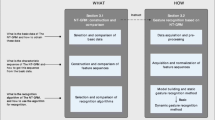Abstract
The recognition of human gestures is a challenging problem that can contribute to a natural man–machine interface. In this paper, we present a new technique for gesture recognition. Gestures are modelled as temporal trajectories of parameters. Local sub-sequences of these trajectories are extracted and used to define an orthogonal space using principal component analysis. In this space the probabilistic density function of the training trajectories is represented by a multidimensional histogram, which builds the basis for the recognition. Experiments on three different recognition problems show the general utility of the approach.
Preview
Unable to display preview. Download preview PDF.
Similar content being viewed by others
References
T. S. Huand and V. I. Pavlović. Hand gesture modelling, analysis and synthesis. In International Conference on Face and Gesture Recognition FG’95, pp 73–79, Zurich, June 1995.
W. T. Freeman, K. Tanaka, J. Ohta, and K. Kyuma. Computer vision for computer games. In Irfan Essa, editor, FG’96, pp 100–105, Kilington, USA, Oct. 1996.
V. I. Pavlović, G. A. Berry, and T. S. Huang. Fusion of audio and visual information for use in human-computer interaction. In Proceedings of Perceptual User Interface, PUI’97, pp 68–70, Banff, Alberta, Canada, Oct. 1997.
T. Starner and A. Pentland. Real-time amercian sign language recognition form video using hidden markov model. Technical Report 375, MIT, Media Laboratory, 1995.
C. Wren, A. Azarbayejani, T. Darrell, and A. Pentland. Pfinder: Real-time tracking of tge human body. In FG’96, pp 51–56, Killington, USA, Oct. 1996.
T. J. Darrell and A. P. Pentland. Recognition of space-time gestures using distributed representation. Technical Report 197, MIT, Media Laboratory, 1992.
J. W. Davis. Appearance-based motion recognition of human actions. Technical Report 387, MIT, Media Laboratory, 1996.
S. Gutta, I. F. Imam, and H. Wechsler. Hand gesture recognition using ensembles of raidal basis function (rbf) networks and decision trees. International Journal of Pattern Recognition and Artificial Intelligence, 11(6):845–872, 1997.
R. Erenshteyn, P. Laskov, R. Foulds, L. Messing, and G. Stern. Recognition approach to gesture language understanding. In ICPR’96, pp 431–435, Vienna, Austria, 1996.
J. L. Crowley and F. Bérard. Multi-modal tracking of faces for video communications. In CVPR’97, pp 640–645, San Juan, Puerto Rico, June 1997.
3Com. PalmPilot, Users Manual.
J. Martin, D. Hall, and J. L. Crowley. Statistical recognition of parameter trajectories for hand gestures and face expressions. In ECCVWorkshop on Perception of Human Actions, Freiburg, Germany, June 1998.
B. Schiele. Reconnaissance d’Objets utilisant des Histogrammes Multidimentsionnels de Champs Réceptifs. PhD thesis, INP Grenoble, July 1997. In French.
I. Sirovich and M. Kirby. Low-dimensional procedure for the caracterization of human faces. Journal of Optical Society of America A, 4(3):519–524, March 1987.
M. Turk and A. Pentland. Eigenfaces for recognition. Journal of Neuroscience, 3(1):71–86, 1991.
A. Lux and B. Zoppis. An Experimental Multi-language Environment for the Development of Intelligent Robot Systems. In 5 th International Symposium on Intelligent Robotic Systems, SIRS’97, pp 169–174, 1997. Details at http://www-prima.imag.fr/Ravi/.
Author information
Authors and Affiliations
Editor information
Editors and Affiliations
Rights and permissions
Copyright information
© 1999 Springer-Verlag Berlin Heidelberg
About this paper
Cite this paper
Martin, J., Hall, D., Crowley, J.L. (1999). Statistical Gesture Recognition Through Modelling of Parameter Trajectories. In: Braffort, A., Gherbi, R., Gibet, S., Teil, D., Richardson, J. (eds) Gesture-Based Communication in Human-Computer Interaction. GW 1999. Lecture Notes in Computer Science(), vol 1739. Springer, Berlin, Heidelberg. https://doi.org/10.1007/3-540-46616-9_12
Download citation
DOI: https://doi.org/10.1007/3-540-46616-9_12
Published:
Publisher Name: Springer, Berlin, Heidelberg
Print ISBN: 978-3-540-66935-7
Online ISBN: 978-3-540-46616-1
eBook Packages: Springer Book Archive




